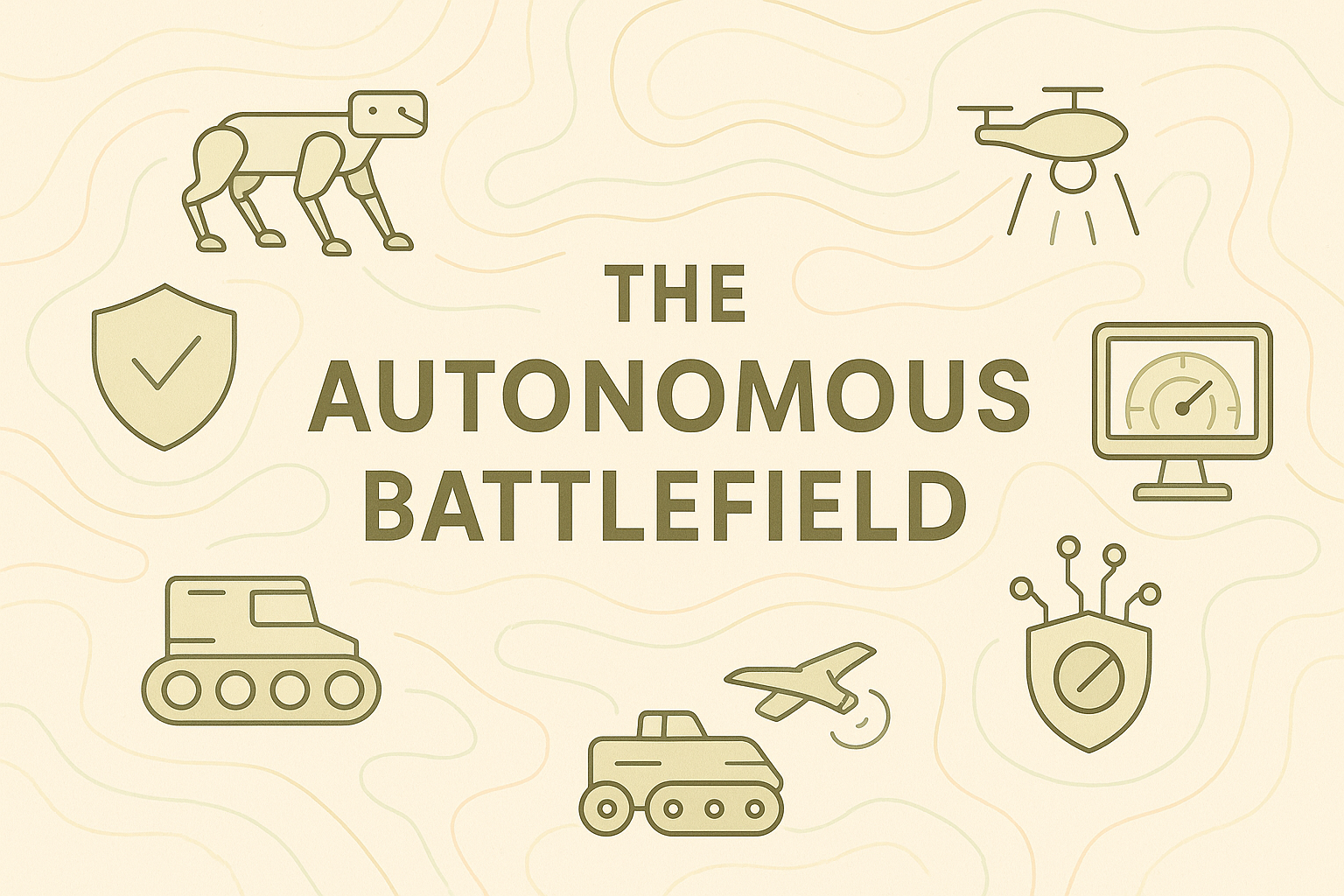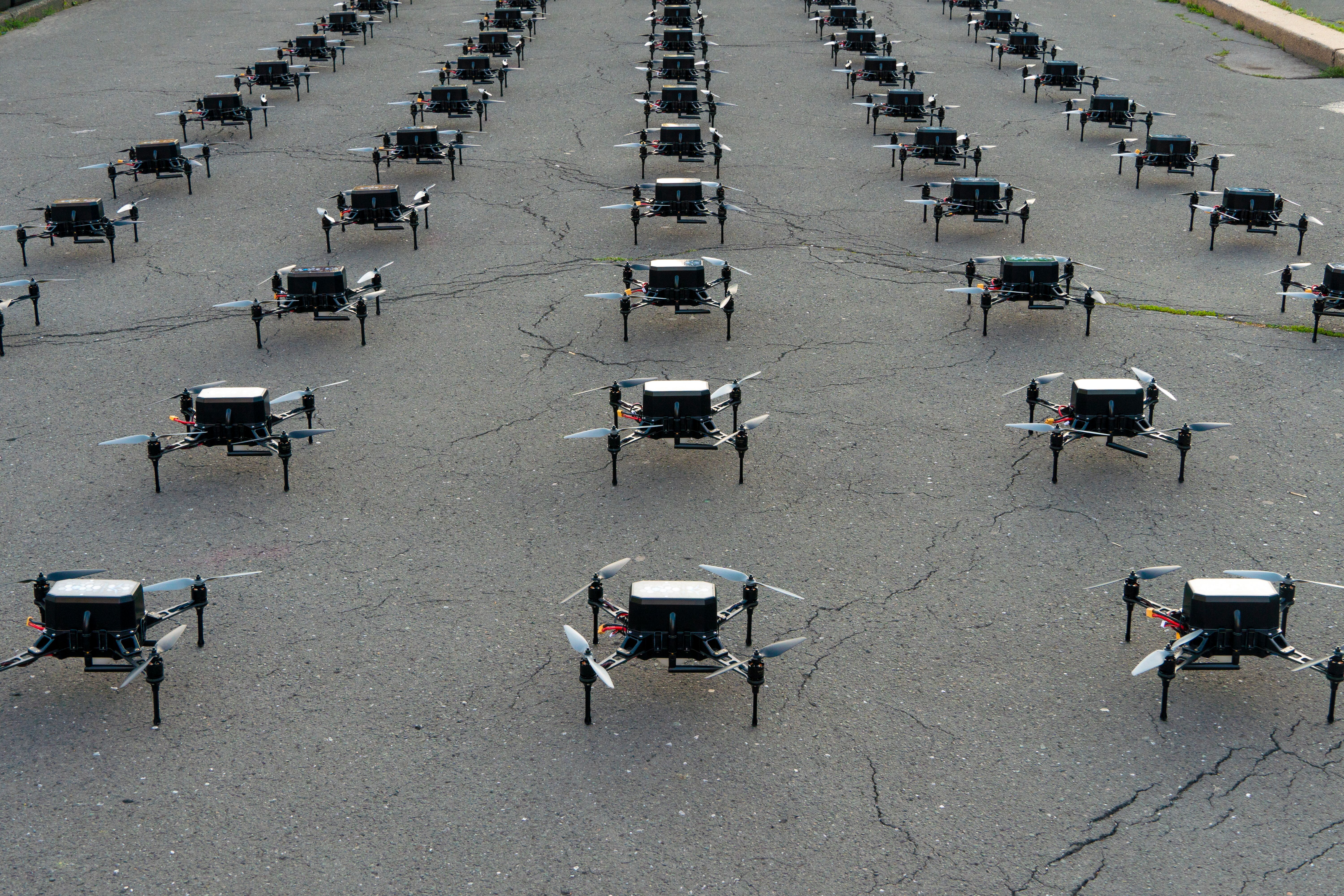AI Landscape: The Autonomous Battlefield

We’ve all seen them.
The videos. The gifs. The viral clips of four-legged robots prancing across rubble, leaping fences, marching in formation. Or rolling, tracked machines with turrets slung low, moving with unsettling precision. Sometimes they dance. Sometimes they carry gear. Sometimes they look like they’re training for war.
They’ve become shorthand for the robot uprising. A glimpse of Terminator. A symbol of how close — or how unready — we are for a world of autonomous machines.
But the reality of the autonomous battlefield is both more mundane and more profound.
Behind the memes and sci-fi fears lies a fast-moving ecosystem where militaries, defense contractors, and startups are deploying real, working robots across training grounds, borders, and battlefields. These aren’t experiments. They’re in service today: carrying gear, scouting terrain, surveilling perimeters, defusing bombs.
The age of autonomous combat systems isn’t coming. It’s already here.
In this AI Landscape, we explore the expanding world of military robotics and battlefield autonomy: how these systems work, who’s building them, where they’re being used, and what it means for investors.
This isn’t about humanoid killing machines. It’s about a new class of platforms — crawling, rolling, flying — that extend human reach into places too dangerous, too remote, or too hostile to send flesh and blood.
We call it the autonomous battlefield. But the ground it covers is more than war. It’s surveillance. Disaster response. Perimeter control. Logistics. And yes — sometimes, lethality.
Welcome to the frontline of robotic autonomy.
The People Behind the Bots
Sergeant Maya Lopez has never touched the joystick.
When her unit deployed to a remote outpost in Eastern Europe last spring, the robotic mule was already waiting. “It knows the route,” her commanding officer told her. “Just sync it, and let it follow.”
Sync it, she did. And for six months, the four-legged bot hauled ammo crates, MREs, and medical kits through trails so muddy even ATVs bogged down. Maya didn’t “drive” the mule. She gave it waypoints. When a hillside collapsed, it rerouted. When gunfire erupted in the valley, it took cover beside a rock.
“It’s weird,” she admits. “It’s not a teammate. But it’s not a machine like a drone either. It’s something… in between.”
Maya’s story isn’t sci-fi. It’s the day-to-day reality of a battlefield being reshaped by autonomous systems — one cargo-carrying robot at a time.
Across the Atlantic, James Carter manages a quiet, far less kinetic deployment.
By day, he’s a security director for a major utility company. By night, he logs into a web dashboard where three robotic quadrupeds patrol the perimeter of a sensitive power plant. The bots navigate gravel paths, weave around fence posts, and periodically stop to scan their surroundings with infrared cameras. If they detect movement, Carter gets a ping.
He can take manual control if needed. But most nights, the bots complete their route unaided.
“It’s like I’m supervising a team that doesn’t sleep,” he says.
Carter doesn’t wear a uniform. His bots aren’t armed. But the overlap with military applications is obvious.
In both cases — Maya’s battlefield mule, Carter’s security patrol — the same foundations are at work: autonomous navigation, sensor fusion, edge AI decision-making, and human override.
What they represent isn’t just robots moving through space. It’s human-machine collaboration evolving in real time.
Why Now? The Forces Fueling the Autonomous Battlefield
If you’re wondering why these machines are suddenly moving from DARPA prototypes to deployment orders, the answer lies in an intersection of technology, geopolitics, and battlefield necessity.
The last five years have delivered a quiet revolution in key enabling technologies.
Battery technology has caught up — allowing ground robots to carry meaningful payloads without running out of power before lunch. AI perception models, trained on massive datasets, now let machines “see” terrain, obstacles, and threats with human-like intuition. LIDAR, thermal imaging, and sensor fusion have gone from exotic to off-the-shelf.
And perhaps most critically: militaries are no longer willing to put soldiers in harm’s way when an autonomous platform could take the risk.
In Ukraine, loitering munitions and low-cost drones have turned battlefields into test labs for autonomous systems. NATO has accelerated funding for unmanned platforms. The U.S. Department of Defense’s Replicator initiative has pledged to deploy thousands of attritable autonomous systems in the next two years.

The pressure is on.
Every major defense contractor — and a new crop of venture-backed startups — sees the writing on the wall: the future of force projection is unmanned, autonomous, and AI-augmented.
This isn’t theory. It’s procurement.
And while humanoid robots capture imaginations, it’s the simpler forms — four legs, six wheels, tank treads, quadrotors — that are quietly filling the procurement pipelines today.
The world’s militaries aren’t waiting for science fiction.
They’re buying what works now.
The Battlefield Autonomy Stack
Beneath every robotic dog, rolling scout, or unmanned mule is a hidden stack of technology. These machines don’t just run on motors and servos — they’re powered by an orchestra of AI, hardware, and connectivity, layered together like a combat-ready operating system.
At the base lies mobility hardware: robotic limbs, ruggedized wheels, suspension systems engineered for mud, sand, or urban debris. But hardware alone doesn’t make an autonomous combat platform useful.
Layered above is sensor fusion — combining LIDAR, thermal imaging, radar, and high-res cameras to build a 360-degree map of the robot’s environment in real time. This map lets the platform avoid obstacles, detect humans, or pinpoint heat signatures.
Next comes the AI brain, running perception models and decision-making algorithms onboard. Unlike drones piloted remotely or robots controlled by joystick, these systems carry their own computational firepower — what technologists call edge AI. This allows them to navigate, patrol, and identify targets even in GPS-denied or jammed environments.
Communications glue the stack together. Autonomous systems are increasingly tied into C4ISR networks — Command, Control, Communications, Computers, Intelligence, Surveillance, and Reconnaissance. This integration allows machines to feed data upstream, receive new waypoints, or synchronize actions with manned and unmanned teammates.
Finally, many systems include a human-in-the-loop interface — software dashboards where operators can supervise, override, or redirect autonomous platforms without direct manual control.
What makes a battle-ready robot viable isn’t just its physical form.

It’s this full-stack integration — a machine capable of seeing, deciding, acting, and collaborating inside a broader digital battlespace.
And it’s that stack — not just the metal — that investors and militaries are betting on.
The Public Players in the Autonomous Battlefield
For investors hoping to ride the rise of the autonomous battlefield, there’s no single ticker that spells “BOT.” Instead, exposure lives inside defense primes, aerospace giants, and a few emerging players quietly building the battlefield’s next generation.
At the top sits AeroVironment (AVAV), the tactical drone specialist whose loitering munitions have become synonymous with modern drone warfare. While best known for airborne systems, AeroVironment is pushing deeper into autonomous control, swarming logic, and ground support robotics — a pure-play on unmanned systems in a world that no longer needs pilots at every joystick.
Teledyne FLIR (TDY) approaches from the sensor side, pairing advanced imaging tech with bomb-disposal robots deployed across military and law enforcement units globally. Their robots don’t carry weapons — but they neutralize them, using cameras, LIDAR, and remote manipulation in high-stakes environments.
General Dynamics (GD) has bolted automation onto its armored legacy, developing robotic combat vehicles that can scout, flank, or deliver payloads without risking human crews. Its innovation cadence is slower, but its battlefield presence is unmatched.
Elbit Systems (ESLT), profiled recently in our Company Spotlight, knits together drones, ground robots, and command-and-control networks into fully operational systems already deployed across NATO borders. Its platforms emphasize hybrid autonomy — fast, tactical decisions with human oversight.
Kratos Defense (KTOS) brings an attritable angle: developing low-cost autonomous aerial and ground platforms designed to operate in swarms, saturate defenses, or act as expendable teammates in high-risk missions.
But smaller companies are finding footholds too.
Red Cat Holdings (RCAT) may fly under the radar with a ~$75 million market cap, but its subsidiary, Teal Drones, builds rugged, AI-assisted quadcopters approved for military use under U.S. government security guidelines. Its drones don’t just fly — they stream battlefield intelligence back to command hubs.
And Guardforce AI (GFAI), with roots in security services, has pivoted toward deploying autonomous patrol robots in sensitive facilities. Its robots aren’t battle-ready, but their navigation, surveillance, and AI-assisted monitoring technologies echo military-adjacent use cases — a commercial cousin to battlefield autonomy.
Meanwhile, the defense primes — Lockheed Martin (LMT), Northrop Grumman (NOC) — continue to layer autonomy into existing platforms quietly: testing unmanned tanks, swarming drone formations, and AI-driven targeting within sprawling procurement pipelines.
Investing in the autonomous battlefield isn’t about finding a single product.
It’s about identifying which companies are embedding autonomy, sensors, and AI into the architecture of modern warfare — building not just robots, but ecosystems where those robots can operate, communicate, and decide.
The Private Innovators Pushing the Frontline
While public companies offer investors a doorway into the autonomous battlefield economy, many of the most eye-catching robotics advances are happening inside private startups — firms backed by defense grants, venture capital, and strategic military partnerships.
At the top of every robotics highlight reel sits Boston Dynamics. Famous for its viral videos of robots dancing, leaping, and backflipping, Boston Dynamics’ Spot robot dog is already being tested by military and police forces for surveillance, perimeter patrol, and payload delivery. Now owned by Hyundai, Boston Dynamics blends research credibility with commercial scale, though its battlefield use remains mostly non-lethal.
Anduril Industries is perhaps the buzziest private player in military robotics. Founded by Palmer Luckey, Anduril develops AI-powered defense systems including Ghost drones, autonomous surveillance towers, and the Lattice AI platform that stitches sensors and autonomous devices into battlefield coordination. Backed by Peter Thiel and Andreessen Horowitz, Anduril is aiming not just to build robots — but to own the AI operating system for autonomous defense.
Ghost Robotics plays closer to Boston Dynamics’ lane but with a sharper military focus. Its Vision quadruped robot has already been tested with weapon mounts, sparking headlines and ethical debates. Its platform emphasizes ruggedization, modular payloads, and integration into security infrastructure.
Other innovators include Agility Robotics, whose bipedal robot Digit is designed for logistics and industrial applications but has drawn interest from military logistics programs; and Clearpath Robotics, a Canadian firm whose unmanned ground vehicles are already used for mining, disaster response, and defense research projects.
These startups aren’t building humanoid soldiers.
They’re building specialized platforms — legged, wheeled, tracked, flying — each solving pieces of the autonomy puzzle: navigation, perception, payload handling, swarm logic, human-machine interfaces.
And with every demonstration, test deployment, or field contract, they’re quietly nudging militaries toward a future where humans remain at the edge, but machines increasingly walk (or roll) ahead.
The New Archetype – The Bot Operator
There was a time when warfare meant boots on the ground and hands on weapons. Now, increasingly, it means hands on dashboards.
The rise of battlefield autonomy isn’t just changing machines — it’s changing the people who work alongside them. Enter the bot operator: a soldier, security officer, or technician who no longer fights at the front but guides, supervises, and adapts systems that do.
In military terms, this role is evolving rapidly. A single operator might now coordinate a fleet of autonomous ground vehicles, issue commands via touchscreen, and interpret battlefield telemetry in real-time. It’s less about muscle memory, more about mission oversight. Tactical judgment, digital fluency, and systems thinking matter more than physical strength.
In civilian settings — border security, critical infrastructure, riot control — these archetypes are emerging too. Officers may no longer patrol in person but monitor robotic dogs through thermal feeds, send them to investigate movement, or guide them to waypoints while remaining safely behind walls.
This new class of professionals sits at the intersection of operator and engineer, trained not to build the robots, but to partner with them.
It’s also redefining what it means to “serve.” In the near future, a soldier in a conflict zone may log into a fleet interface and deploy six robots for recon, one for supplies, and another for emergency response — all while staying off the physical battlefield entirely.
And where humans stay involved, the relationship is changing from command-and-control to something more collaborative: a supervised autonomy, where people steer intent and AI handles execution.
The frontline hasn’t disappeared.
It’s just moved behind a screen.
The Investor Lens
For investors, the rise of the autonomous battlefield isn’t a clean sector play — it’s a web of opportunities stitched across defense, robotics, and AI infrastructure.
There are no “robot soldier” tickers on Robinhood. No ETFs labeled “autonomous warfare.” Instead, exposure comes from reading between the lines: defense primes layering in autonomy, robotics firms pivoting to military contracts, and AI startups building the software brains behind it all.
The upside is real. Governments are rapidly rewriting procurement strategies around unmanned systems. The U.S. Department of Defense’s Replicator Initiative plans to deploy thousands of autonomous platforms by 2026. NATO allies are funding swarm drone systems, AI-driven logistics, and robotic surveillance nodes. This is not experimental — it’s budgeted.
Public companies like AeroVironment (AVAV), Kratos Defense (KTOS), Elbit Systems (ESLT), and Teledyne FLIR (TDY) offer partial exposure. Others like General Dynamics (GD) and Northrop Grumman (NOC) are integrating autonomy into larger systems, but with less direct visibility.
On the speculative end, small caps like Red Cat Holdings (RCAT) and Guardforce AI (GFAI) provide higher volatility, but a tighter narrative — they’re niche players trying to ride the autonomy wave from the inside.
Private firms like Anduril, Ghost Robotics, and Agility Robotics may one day offer IPOs, SPAC entries, or acquisition targets — and those with exposure to the venture side or dual-use crossover funds will be watching closely.
But it’s not without risk.
- Ethical and regulatory frameworks are still forming. Will autonomous weapons be banned? Will human oversight be mandated?
- Budgets can shift — even in wartime, politics rules procurement.
- And hype cycles are dangerous: humanoid robots may dazzle YouTube, but investors need to focus on systems with real contracts, real deployments, and real use cases.
The autonomous battlefield revolution is real — but its returns will go to those who understand where autonomy meets deployment, not where headlines meet hope.
The Quiet Advance of Autonomy
If you came looking for Terminators, you might leave underwhelmed.
There are no red eyes. No marching humanoid armies. No Skynet on the horizon.
But the revolution is real.
It rolls on treads through dry riverbeds in the Sahel. It walks on four legs past sensitive facilities in Singapore. It flies over Ukrainian trenches, sees in the dark, and relays targeting data back to humans who still, for now, make the final call.
Autonomous combat systems aren’t coming — they’re already here. In small ways. In incremental deployments. In the dusty corners of procurement sheets. And in those quiet transitions, autonomy is taking ground — not with a bang, but with a budget line and a test deployment and a follow-on order.
Investors who look closely will see it: a distributed ecosystem quietly wiring the battlefield for AI.
Hardware is improving. AI is maturing. Militaries are no longer asking if — but how soon, how safe, how scalable.
And while the headlines will chase humanoids and hype, the real wins — operational and financial — will go to those who understand how autonomy enters the world: slowly, strategically, and through the back doors of procurement and practicality.
This is the terrain.
These are the machines.
This is the landscape of AI in motion — and it’s worth watching, carefully.
Disclosure: This article is editorial and not sponsored by any companies mentioned. The views expressed in this article are those of the author and do not necessarily reflect the official policy or position of NeuralCapital.ai.